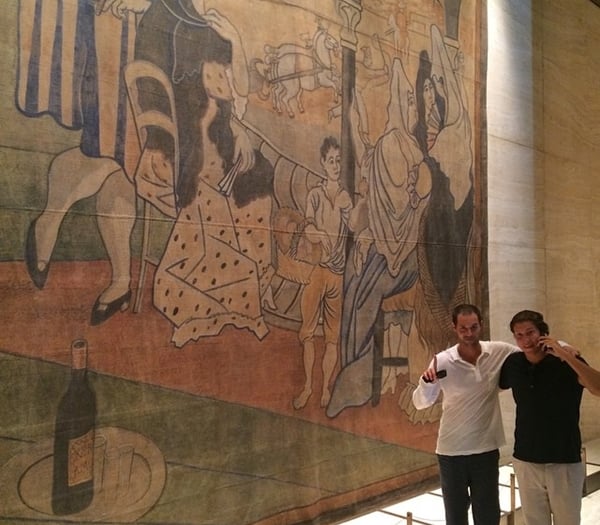Art & Exhibitions
Aby Rosen’s Giant Picasso Leaves the Seagram Building
The 95-year-old tapestry is moving across town.

Photo: Vito Schnabel/Instagram.
The 95-year-old tapestry is moving across town.

Sarah Cascone

A New York landmark is now short one giant Pablo Picasso canvas, as the 95-year-old Le Tricorne has been removed from the Four Seasons restaurant, where it had hung in what was popularly known as “Picasso Alley” since the restaurant opened in 1959. Following a bitter dispute between the painting’s owner, the New York Landmarks Conservancy, and collector and building owner Aby Rosen, the massive artwork exited the Seagram Building early on the morning of September 7th after a painstaking and delicate de-installation process that took all night.
The Picasso’s departure irreparably alters the original vision for the restaurant’s space, as designed by Philip Johnson with input from Phyllis Bronfman Lambert, the daughter of Seagram scion Samuel Bronfman. It was Lambert who hired Seagram architect Mies van de Rohe, and who purchased Le Tricorne for the Four Seasons.
She was convinced the 19-by-20-foot stage curtain was just what the travertine wall between the restaurant’s grill room and pool room needed. It was “wonderful for this space in its color, its tonality, the whole thing, absolutely the right size—it was amazing,” Lambert told Vanity Fair.
Though the painting seemed like the perfect fit to Lambert, Rosen has since claimed that the tapestry was trimmed to fit the space—an accusation Lambert calls a “completely fabricated idea.” Nevertheless, when the Four Seasons interior was granted landmark status by the New York Landmarks Conservancy in 1989, the curtain, as a freestanding work of art, was specifically excluded from that protected designation.
Rosen first attempted to remove Le Tricorne in February, ostensibly to repair the wall on which it hung, as its travertine panels were beginning to buckle. The Conservancy was understandably concerned for the fragile artwork’s safety, and asked a judge to temporarily prevent the tapestry from being moved.
The judge granted that initial stay of execution, but in June an agreement was reached that would mean the end of Picasso Alley. Rosen would pay for the transport and restoration of Le Tricorne, which would henceforth reside at the New York Historical Society.
While Peg Breen, president of the conservancy, is just happy to keep the painting on public display here in the city (the Museum of Modern Art offered to step in, but only to provide storage space), Lambert is less pleased with the compromise, telling VF “I am heartbroken.”
Rosen, while denying claims he called the curtain a schmatte (the Yiddish word for rag), is unapologetic for his decision to get rid of the work. “It is my property,” he told VF. “It is a piece of art that is in my property. I should have the right to demand it to be removed for whatever reason.”
And, as reported by the New York Times, removed it was. A team of art installers led by Tom Zoufaly constructed a tower of steel scaffolding with no less than 10 tiers, and examined the canvas in order to determine how it had been installed by Zoufaly’s mentor, James Lebran: hundreds of staples to a two-piece wood frame screwed into the wall, with Velcro stapled along the sides.
“Anything goes wrong, just stop what you’re doing,” Zoufaly told his team, warning them that “I don’t want to hear any screaming, yelling.” Luckily, the process, although slow, was uneventful. Without ever touching the floor or suffering a single tear, the painting was carefully covered in protective wrapping, rolled up, and inserted into a 23-foot-long tube for transport.
During the painting’s final days at the Four Seasons, the restaurant saw an influx in reservations, as well as visitors who stopped by to see what is believed the largest Picasso in North America in situ. Vogue magazine even photographed hip hop star Iggy Azalea, singer of song-of-the-summer “Fancy,” in front of the painting this spring.
Although the future is clear for Le Tricorne, Rosen has yet to decide what he will do with the now-empty Picasso Alley space. “I mean, there are so many great artists,” he said. “Brice Marden would be fantastic. But I would like to get a really beautiful Picasso painting. I’m talking to various museums. I have lots of choices. Everybody wants to hang something great.”
Four Seasons co-owner Julian Niccolini is also optimistic about the change. “I always felt that the restaurant is not really something that should stay the same—that’s why we change the menu every day,” he told the Associated Press. “When the painting is gone, something else is going to come up that, I’m sure, is going to be spectacular.”